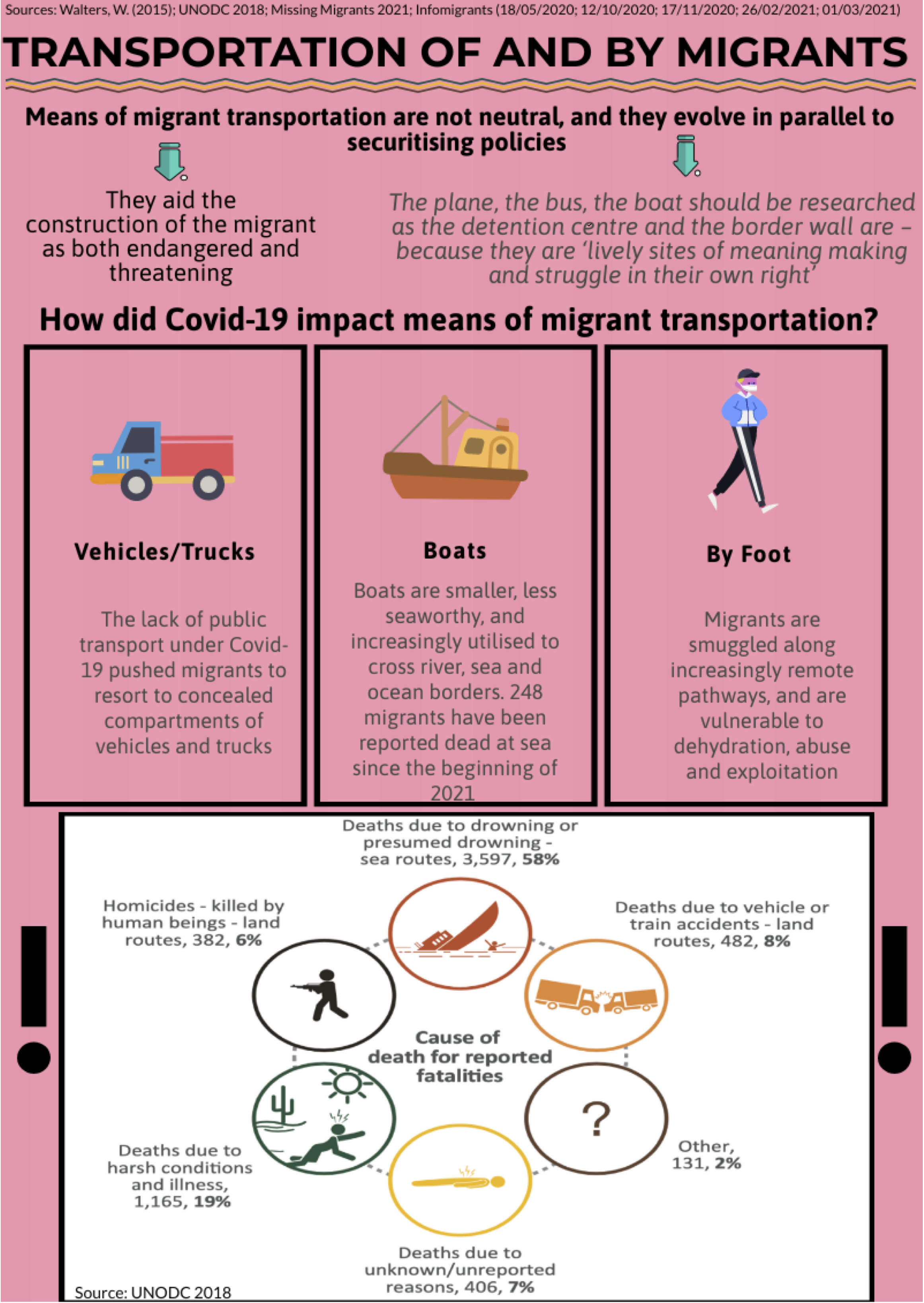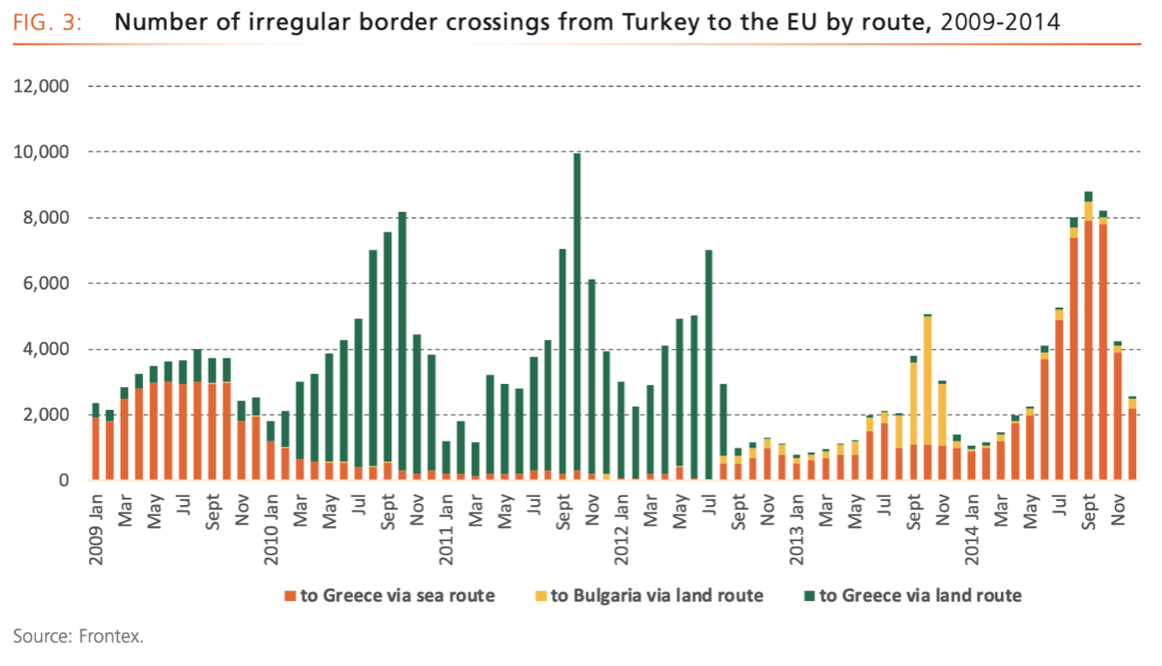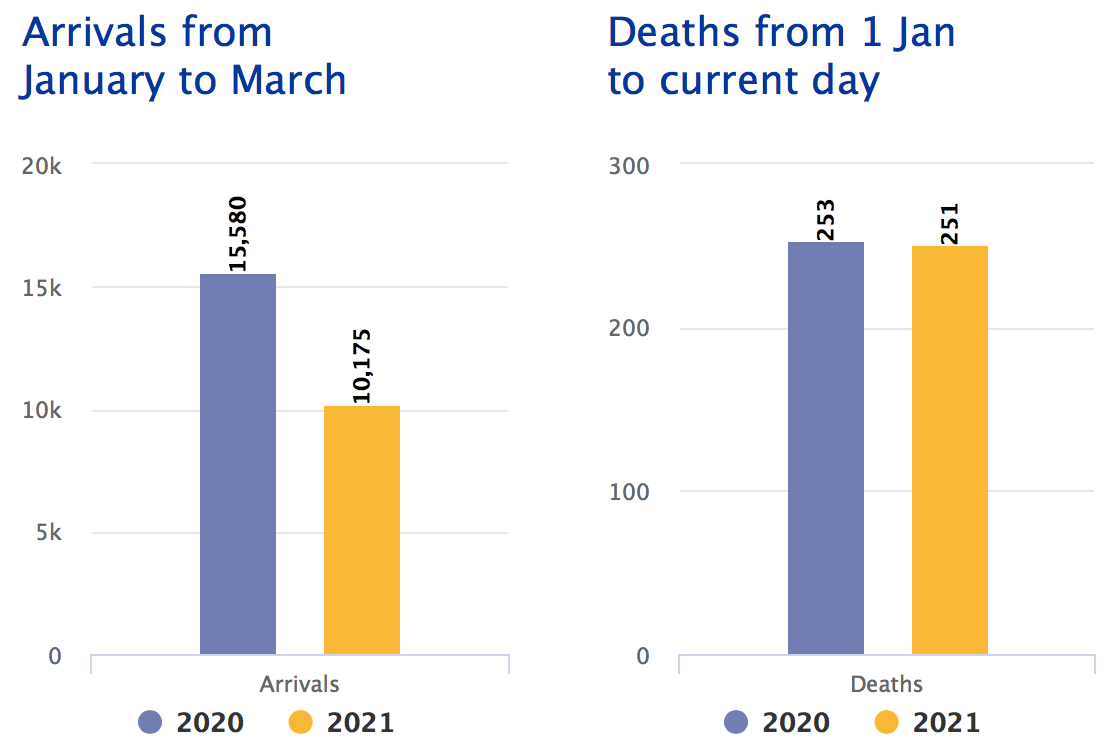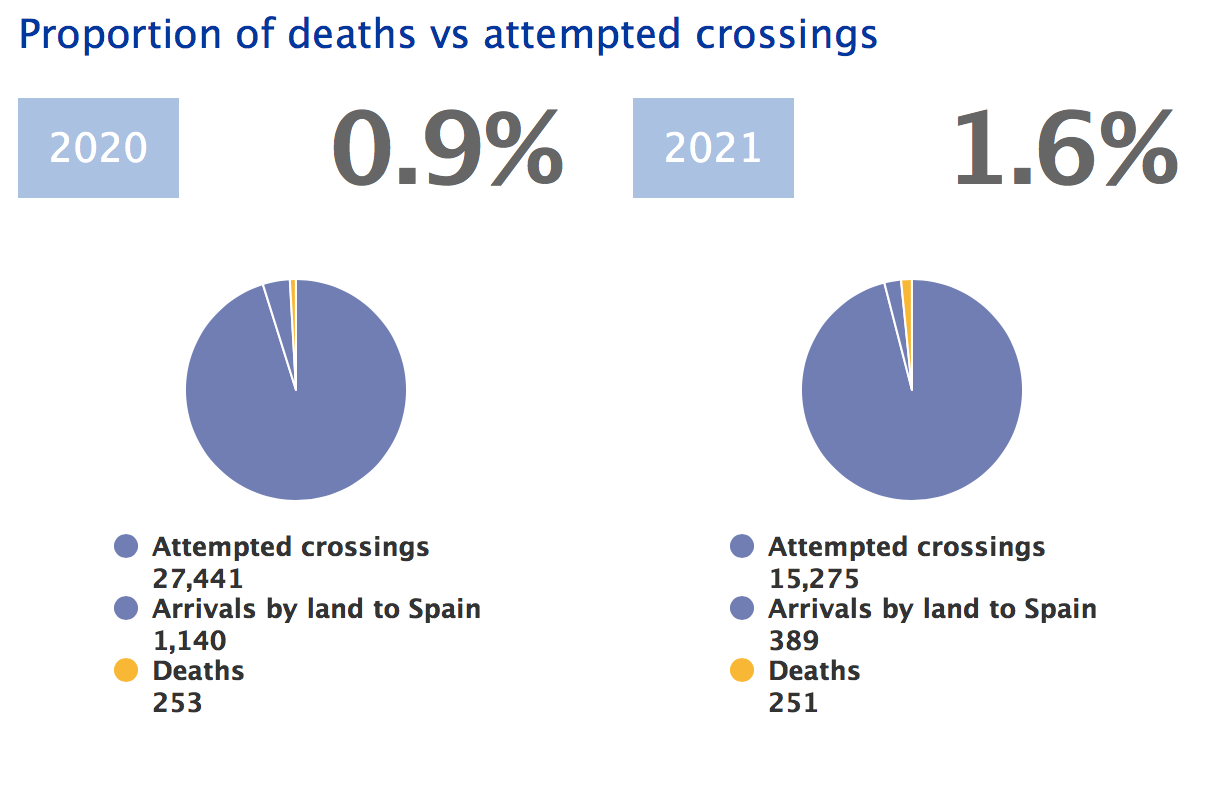
Transportation of Migrants and by Migrants
William Walters (2015) [1] advances the notion of ‘viapolitics’ as an umbrella term linking notions of migration and mobility, and individuating a diagonal line for the opening of new perspectives on migration by allowing to shift the focus on the means of migrant transportation (vehicles, roads, boats…). Accordingly, the means of migrant transportation are a stage for political action, and exist and participate in broader migration politics. Moreover, they can be understood as mobile zones of governance, since ‘the way that ships, trains, buses and other vehicles mediate the public understanding of migration and border-crossing is rarely neutral’[1]. Crucially, the means of migrant transportation are integral to the way in which the public perceive notions of ‘illegal migration’ – as for boats, containers and vehicles are central to the visual dramatization of migration. In what the author delineates as the visual economy of migration, vehicles figure prominently as agents for the deepening of the sentiments of unease and desperation attached to migrants[1]. Such reality exists within a broader framework of securitisation, which is legitimised by means of the co-existence of factors of detection, deterrence and salvation. The intersection of these dynamics can be highlighted in the expansion of Frontex’s operations in the Mediterranean, which appeals to its parallel mandates of defending Europe’s borders and saving migrants from death at sea. Here, the means of transportation (boats) are absolutely fundamental to the depiction of such dynamics, and of migrants as both endangered lives and bodies in motion. Therefore, (in this case) boats become mobile zones of governance, as they participate in the visual production of complementary sentiments of fear of unauthorised migration as a violation to national borders, and the tragedy of people being jeopardized and lost at sea. Whereas such dynamics vary across different geographical and socio-political contexts, means of migrant transportation remain crucial elements within practices of securitisation and forced removal. Crucially, the plane, the bus, the boat should be researched as the detention centre and the border wall are – because they are ‘lively sites of meaning making and struggle in their own right’[1].

The role of means of migrant transportation as mobile sites of governance can be identified in the graph above showing that irregular border crossings from Turkey to Europe neatly change in 2012, as the escalation of the Syrian civil war fed into an international migration crisis that promoted the enhanced securitisation of European borders. This was central to the interchange from mainly on-land migration towards sea migration [2]. Likewise, movement restrictions and border closures under Covid-19 have enhanced migrant reliance on smugglers, and have prompted a change in the routes and means of transportation of migrants [3]. In fact, smugglers have developed new, and significantly more perilous routes for sea and land crossings [3]. Migrants are increasingly being smuggled along highly remote paths to allow their crossing of national borders without detection [3]. Furthermore, the suspension of public transport has depleted regular road travel options, and has pushed migrants to resort to more dangerous options, such as cargo vehicles [3]. Crucially, migrants are being hidden in concealed compartments of vehicles, and are thus forced to migrate under life-threatening conditions [4]. In October 2020, 8 suffocating migrants were found inside a lorry in Germany [5], and several similar incidents have been reported in Italy, where migrants have been found in lorries and refrigerated trucks [6]. Moreover sixty-four Ethiopian nationals crammed inside a freight container in north-west Mozambique were found dead in March 2020 [7]. With temperatures reaching 34°C (93°F) in the area at the time, the victims were discovered inside a blue cargo container loaded on the truck [7]. Of all the migrants transported were illegally inside the truck travelling from Malawi to Mozambique, only 14 survived, with everyone else (64) dead due to asphyxiation [7]. Deadly means of migrant transportation are also rooted in South Africa’s history, as reports of migrants jumping or being thrown out of trains go back to the 1990s [8]. In 1999, several incidents were reported of migrants being assaulted and robbed on the train, during their return to Mozambique [8]. Beyond harsh treatment, migrants fell victim to corrupt guards, who offered to allow them to jump off moving trains for money. Crucially, some jumped but most were thrown off the trains by the guards themselves. Many died, and most presented heavy injuries [8]. This topic is especially urgent and current if we consider South Africa’s surge in violent attacks against foreign truck drivers transiting in the country [9]. With the emergence of the Covid-19 virus, levels of poverty and desperation have become deeper, and attacks to trucks have increased [9]. During the last week of November 2020, at least 30 trucks were attacked across South Africa [9]. On one of these days Nine trucks were set on fire, their drivers attacked, and their cargo looted [9]. All the attack reports testified how the truck drivers were violently attacked, prior to having their trucks set on fire [9]. This situation must be analysed in relation to the ongoing protests by unemployed South African truck drivers, who are accusing companies of disproportionately hiring foreign nationals to exploit their desperation [9]. In fact, widespread cries for the regulation of the sector have been directed towards the government in order to promote the regularisation of the sector, yet some companies engage in the exploitation of migrants who sometimes do not own papers, and are not unionised nor likely to request higher wages [9]. While the situation falls in a grey area of simultaneous solidarity with truck drivers and condemnation of the violent attacks, it also must be understood as profoundly interconnected to South Africa’s fragile political climate, which allows for the high jacking of legitimate concerns for political ends [9]. With the nationalist #SouthAfricaFirst wave spreading across the country and feeding into anti-foreigner rhetoric, the risks of such violent actions reside in their capacity to echo among the growing numbers of the unemployed and the national poor [9]. Beyond hazarding the country and the migrants with desperation-fed populism and growing violence, the freeway madness of burning trucks also has extensive repercussions on South Africa’s economy. With more than 70% of freight being transported by road, generating chaos on the freeways represents a ramifying sabotage that retains the capacity to further exacerbate current social disparities and tensions [9].
Means of transportation become the symbolic locus of the neglect of migrants and displacement, as a result of the complexity of instances in which migrant lives are abused and hazarded. In 2017, asylum seeker Francine Kalala sued South Africa’s government after two hospitals turned her away while in labour, forcing her to give birth in a train station [10]. In fact, after traveling an approximate 60 miles (96.5km), during which she was in labour, Kalala arrived at the railroad station, where she was forced to give birth [10]. Here, she was assisted by security guards and was watched by hundreds of onlookers [10]. The rejection she faced from hospitals was motivated by her migrant status, notwithstanding the fact that the South African constitution entitles migrants and asylum seekers to the same free basic health services as citizens [10]. Likewise, recent reports from Libya underline how migrants seeking to reach Tripoli are driven on buses deep into the desert, where they are subsequently crammed into cars with no seats and that hold between 10-12 people [11]. During the journey, migrants have no knowledge of the route or of the timing of their movements, and are extremely vulnerable to abuse and exploitation [11]. In addition to this, migrants are increasingly being trafficked with cargo trains and freight vehicles [3]. On the other hand, boats utilised by smugglers to traffic migrants across the sea are significantly smaller and less seaworthy than prior to the pandemic [3]. The implications of such new forms of sea-crossing methods are tragic, as reported in the diagrams below.


[12] https://missingmigrants.iom.int/region/mediterranean
With the global coronavirus pandemic and national/regional restrictions, in 2020 the number of migrant deaths reported amounted to 253, with 27,441 attempted crossings reported. In the first trimester of 2021, 251 migrants have been reported to be dead, with 15,275 attempted crossings. Such data indicates a growth in the proportion of deaths to attempted crossings from 0.9% in 2020 to 1.6% in 2021 [12]. Between the last week of February 2021 and early March, 6 rescues were carried on by NGOs in the Mediterranean, with more than 550 migrants being rescued from wooden boats and inflatable dinghies [13]. Moreover, small boats are increasingly being used to cross river borders and sea [3]. The urgency of focusing on the means of migrant transportation resides also in the future loosening of travel restrictions, and its impact on international migration [13]. The large limitations on mobility during lockdown are likely to promote the increased movement of people across borders in the future, with new smuggling methods posing a terrible threat to the safety of migrants [13]. Finally, since most migrants travel with little to no documentation, it becomes significantly difficult for loved ones to locate them when they go missing. With migrants dying at sea and on land due to extremely hazardous means of transportation, heavily securitised national borders, and abusive smuggling networks, the number of missing migrants is constantly increasing [14]. This has prompted the IOM to launch a campaign in 2014, known as IOM’s Missing Migrant Project, which seeks to track incidents involving migrants who have died or gone missing during their journey of migration [14]. The International Red Cross in collaboration with the IOM project aims to assist in the search for missing family members, and establishment of a searching network restoring Family Links Network and such tracing service is available in 190 countries [14].
It is clear that different modes of transport taken by migrants are often precarious, are becoming increasing so, and there are very real risks of harm or death. Moreover migrants engaged in the transport of goods are also in some instances at risk of attacks and looting. Transport of and by migrants is certainly an area in which more research is required and better, safer transport must be adopted and promoted.
INTEREST IN WRITING SOMETHING?
If you are interested in contributing the SIHMA Blog on the Move please contact us at: https://www.sihma.org.za/contact or if you are interested writing an article to be reviewed and published in the African Human Mobility Review, please follow this link on making a submission: https://www.sihma.org.za/submit-an-article
James Chapman and Ginevra Gianardi
SIHMA SIHMA
Project Manager Research and Communication Intern
- Walters, W. (2015) “Migration, Vehicles, and Politics: Three Theses on Viapolitics”; European Journal of Social Theory Vol. 18 (4) p. 469-488
- UNODC, Global Study on Smuggling of Migrants 2018 (United Nations publication, Sales No. E.18.IV.9).
- RELIEFWEB 20 Jul 2020 https://reliefweb.int/report/world/migrant-smugglers-are-profiting-travel-restrictions
- INFOMIGRANTS 18 May 2020 https://www.infomigrants.net/en/post/24819/europol-migrant-smuggling-patterns-changing-due-to-coronavirus
- INFOMIGRANTS 12 October 2020 https://www.infomigrants.net/en/post/27861/germany-suffocating-migrants-discovered-in-truck
- INFOMIGRANTS 17 November 2020 https://www.infomigrants.net/en/post/28556/italy-migrants-including-teens-found-in-refrigerated-truck
- The Guardian, 24 March 2020 https://www.theguardian.com/world/2020/mar/24/64-ethiopians-found-dead-in-truck-in-mozambique#:~:text=“A%20truck%20transporting%20illegal%20immigrants,64%20people%20were%20found%20dead.&text=Amélia%20Direito%2C%20a%20provincial%20immigration,men%2C%20of%20whom%2064%20suffocated
- Harris, B. (2001) “A Foreign Experience: Violence, crime and xenophobia during South Africa’s transition” http://www.csvr.org.za/docs/foreigners/foreignexperience.pdf
- DAILY MAVERICK, 28 Novermber 2020 https://www.dailymaverick.co.za/opinionista/2020-11-28-targeting-foreign-truck-drivers-hurts-everyone/
- REFUGEES DEEPLY, 6 December 2017, South Africa hospitals accused of mistreating pregnant migrants https://deeply.thenewhumanitarian.org/refugees/articles/2017/12/06/south-africa-hospitals-accused-of-mistreating-pregnant-migrants-2
- INFOMIGRANTS 26 February 2021 https://www.infomigrants.net/en/post/30445/exclusive-smuggling-network-source-reveals-harrowing-details-of-migrants-death-journey-inside-libya-2-2
- MISSING MIGRANTS, 9 March 2021 https://missingmigrants.iom.int/region/mediterranean
- European Commission, DG Migration & Home Affairs, “A Study on smuggling of migrants” Final report 2015
- SIHMA, 16 February 2021 https://sihma.org.za/Blog-on-the-move/missing-migrants-and-iom-global-migration-data-analysis-centre-gmdac-webinar
BIBLIOGRAPHY
- DAILY MAVERICK, 28 November 2020 https://www.dailymaverick.co.za/opinionista/2020-11-28-targeting-foreign-truck-drivers-hurts-everyone/
- European Commission, DG Migration & Home Affairs, “A Study on smuggling of migrants” Final report 2015
- Harris, B. (2001) “A Foreign Experience: Violence, crime and xenophobia during South Africa’s transition” http://www.csvr.org.za/docs/foreigners/foreignexperience.pdf
- INFOMIGRANTS 1 March 2021 https://www.infomigrants.net/en/post/30541/15-migrants-feared-dead-hundreds-rescued-off-libya
- INFOMIGRANTS 12 October 2020 https://www.infomigrants.net/en/post/27861/germany-suffocating-migrants-discovered-in-truck
- INFOMIGRANTS 17 November 2020 https://www.infomigrants.net/en/post/28556/italy-migrants-including-teens-found-in-refrigerated-truck
- INFOMIGRANTS 18 May 2020 https://www.infomigrants.net/en/post/24819/europol-migrant-smuggling-patterns-changing-due-to-coronavirus
- INFOMIGRANTS 26 February 2021 https://www.infomigrants.net/en/post/30445/exclusive-smuggling-network-source-reveals-harrowing-details-of-migrants-death-journey-inside-libya-2-2
- MISSING MIGRANTS, 9 March 2021 https://missingmigrants.iom.int/region/mediterranean
- REFUGEES DEEPLY, 6 December 2017, South Africa hospitals accused of mistreating pregnant migrants https://deeply.thenewhumanitarian.org/refugees/articles/2017/12/06/south-africa-hospitals-accused-of-mistreating-pregnant-migrants-2
- RELIEFWEB 20 Jul 2020 https://reliefweb.int/report/world/migrant-smugglers-are-profiting-travel-restrictions
- The Guardian, 24 March 2020 https://www.theguardian.com/world/2020/mar/24/64-ethiopians-found-dead-in-truck-in-mozambique#:~:text=“A%20truck%20transporting%20illegal%20immigrants,64%20people%20were%20found%20dead.&text=Amélia%20Direito%2C%20a%20provincial%20immigration,men%2C%20of%20whom%2064%20suffocated
- UNODC, Global Study on Smuggling of Migrants 2018 (United Nations publication, Sales No. E.18.IV.9).
- Walters, W. (2015) “Migration, Vehicles, and Politics: Three Theses on Viapolitics”; European Journal of Social Theory Vol. 18 (4) p. 469-488
Categories:
Tags:

